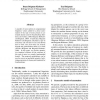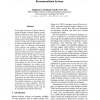NAACL
2010
13 years 9 months ago
2010
Machine translation benefits from two types of decoding techniques: consensus decoding over multiple hypotheses under a single model and system combination over hypotheses from di...
NAACL
2010
13 years 9 months ago
2010
Sentence fusion enables summarization and question-answering systems to produce output by combining fully formed phrases from different sentences. Yet there is little data that ca...
NAACL
2010
13 years 9 months ago
2010
The question of how meaning might be acquired by young children and represented by adult speakers of a language is one of the most debated topics in cognitive science. Existing se...
NAACL
2010
13 years 9 months ago
2010
In this paper, we present a dependency treebased method for sentiment classification of Japanese and English subjective sentences using conditional random fields with hidden varia...
NAACL
2010
13 years 9 months ago
2010
A number of recent articles in computational linguistics venues called for a closer examination of the type of noise present in annotated datasets used for benchmarking (Reidsma a...
NAACL
2010
13 years 9 months ago
2010
In this paper we present an opinion summarization technique in spoken dialogue systems. Opinion mining has been well studied for years, but very few have considered its applicatio...
NAACL
2010
13 years 9 months ago
2010
Knowledge extraction from online repositories such as PubMed holds the promise of dramatically speeding up biomedical research and drug design. After initially focusing on recogni...
NAACL
2010
13 years 9 months ago
2010
Perceptron training is widely applied in the natural language processing community for learning complex structured models. Like all structured prediction learning frameworks, the ...
NAACL
2010
13 years 9 months ago
2010
We explore the relation between word sense subjectivity and cross-lingual lexical substitution, following the intuition that good substitutions will transfer a word's (contex...
NAACL
2010
13 years 9 months ago
2010
Typical statistical machine translation systems are trained with static parallel corpora. Here we account for scenarios with a continuous incoming stream of parallel training data...


